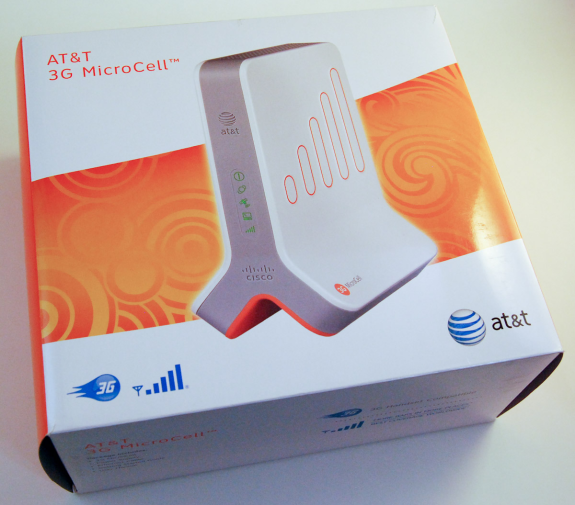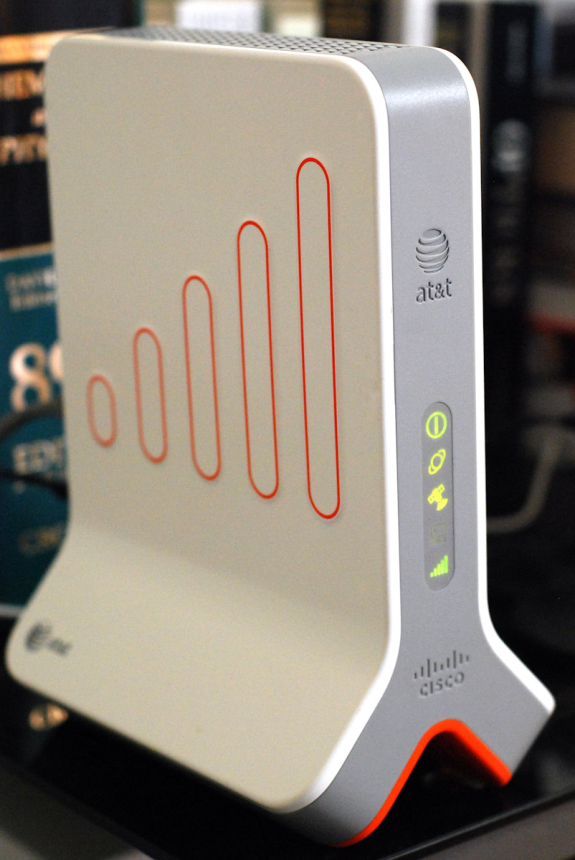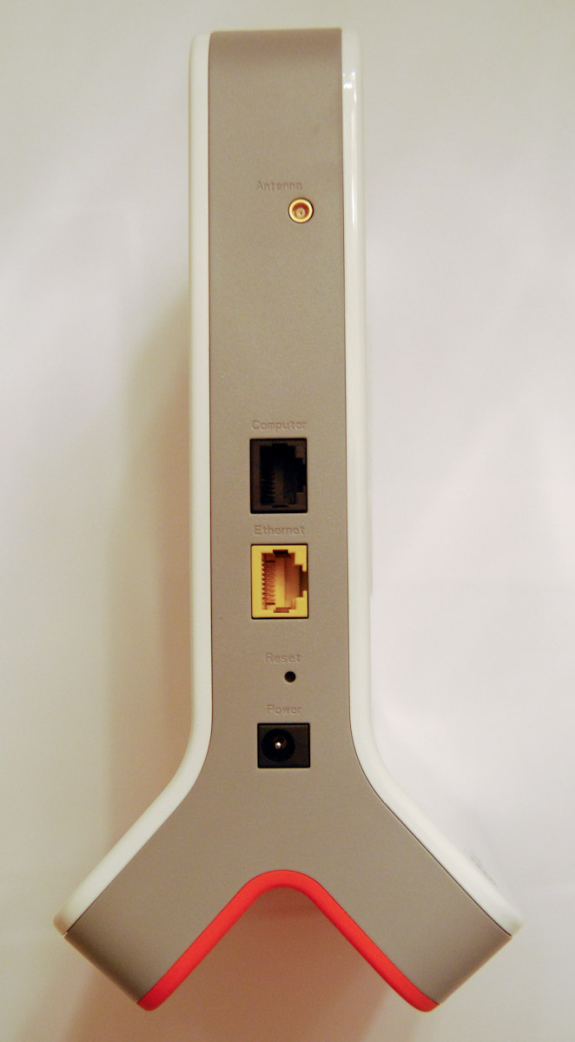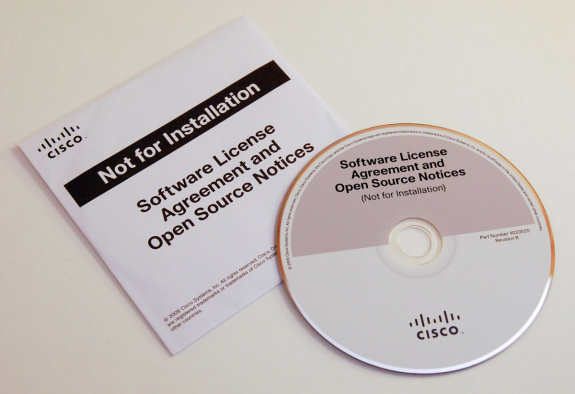AT&T 3G MicroCell: A Comprehensive Exploration
by Brian Klug on April 1, 2010 1:55 AM EST- Posted in
- Smartphones
- AT&T
- Microcell Review
- Mobile
Inside is just about everything you'd expect. There's a standard quick getting started guide if you're reading-challenged, an equally straightforward but more hefty users manual, power supply, and a yellow ethernet cable. Then there's the device itself, bearing Cisco branding and AT&T logos. On its front are five status LEDs: power, ethernet, GPS, computer, and 3G cellular.
The "computer" status LED is interesting - Cisco suggests connecting the microcell in-line with your internet connection, before your router in what they call a "priority mode" configuration. This makes sense, as it offers an easy connection method for users that either don't know about QoS, NAT, or port forwarding, or aren't competent enough to configure them. I didn't investigate priority mode in much detail, instead using QoS and port forwarding rules of my own, but more on that later.
Powered up and running - your very own "cancer box"
On the back are two ethernet ports. The yellow one is what we're interested in, as this is the primary connection for internet. The black one is labeled "computer," and as noted earlier and is for connecting another device behind and in line with the microcell - ostensibly a router or your computer if you lack one. There's also an antenna jack for connecting an external GPS antenna if you can't install the device near a window, or if your windows have a coating which attenuates GPS frequencies. AT&T offers absolutely no guidance of any kind about what type of port this is, but from experience it appears to be MMCX or possibly RP-MMCX. There's also a reset pin hole and power adapter.
Backside of the AT&T MicroCell
Interestingly, there's also an open source license agreement notice CD and sleeve. I half expected a complete dump of all the relevant code given the CD, but instead of Cisco effectively using the 700 MB of storage, they parked one 591 kilobyte, 281 page long PDF document with all the FOSS licenses for packages used on the MicroCell. No, I'm not even joking, this CD literally has one half megabyte file on it. What's even more hilarious is that the file is actually linked for download during the registration process, which makes a heck of a lot more sense.
Not for installation - for reading during that long activation process
Of course, for your amusement, I went through the whole document and extracted all the open source packages cited. There are 24 licensed pieces of software, but the takeaway is that the femtocell is running BusyBox 1.8.2. Ostensibly, most of the code is being used for routing packets through what amounts to a router when you've put the device in "priority mode," but as we'll discover later there's plenty more going on too.














63 Comments
View All Comments
Some1ne - Thursday, April 1, 2010 - link
So let me get this straight. I'm supposed to pay AT&T for access to a device that uses my own Internet connection to patch up holes in their network? That's just ridiculous. It's AT&T's inadequate network coverage that makes these devices necessary in the first place, and now they're actually trying to profit off of having poor network coverage. Pretty much removes any incentive for them to improve their network, now doesn't it?These devices should be provided free of charge, as a "sorry you can't actually use the network that you paid to access" kind of token. Anyone who pays for one of these is just giving AT&T one more reason not to fix their coverage issues.
Alexstarfire - Thursday, April 1, 2010 - link
I rather agree. Makes you wonder what they actually do with all the money they receive monthly. Also means that if you purchase one, much like how it should be if you use an unlocked phone, that your monthly bill should drop in price. Except in this case if they are using your broadband connection then it should practically be free since it provides next to no burden on them, though I don't know what happens after it goes through the connection.therealnickdanger - Thursday, April 1, 2010 - link
How do you know that the actual cost of the device and the technology driving it isn't already subsidized by your bill? Perhaps you're only paying 10% of what it really costs.vol7ron - Thursday, April 1, 2010 - link
Even if a subsidy were included, which would only cover some (not all) of the costs, the fact that people have to pay anything more for it is ridiculous given the nature of what a cell company is: a service. Cell phone companies are in business for one reason and by making you pay anything more to receive the core product is truely sad.There are other companies, like Cisco, that have built their own repeaters and Mobile-to-VOIP products, which I commend, because they are a technology company not providing the service. They're taking something bad, that they don't have control of, and making it bearable. Cell phone providers are at the other end, they have full control but are making you pay more, even though you aren't getting the initial benefit of what you're paying for in the first place.
zinfamous - Thursday, April 1, 2010 - link
This is kind of where I sit with the argument. a one-time ~$150 cost to the customer *may* be cheaper in the end, than having a network-wide upgrade that increases costs across all customers, paying more and more per month.Perhaps it also improves access to those willing, and needing increased network performance, paying a bit more for the premium, while those customers with little need for the bandwidth go on about their normal use, paying what they always have. It's like...a single-payer network structure! :D
DoeBoy - Thursday, April 1, 2010 - link
IT seems to me some people forget that companies are in business to make money. This is a great way for ATT to make a lot of extra money. I live in a rural area and i complain all the time in an area they say has coverage that does not at all. While this would aid me in getting better service it also would require me to pay for an inet connection which is not covered by att. Clearly they aren't a moral company when your service is so bad you have to have a product that uses some other technology(a la internet) and then charge the person not only for that product that gets you service but not even lower your bill since you technically arent using their towers really at all under this sucker. Clearly Verizon and ATT are both big 500lb gorillas. In europe its much easier to get a cheap cell phone deal and coverage. Clark Howard seems to think ATT and Verizon are going to end up being more corporate and smaller companies like t-mobile, cricket, metropcs and what not will fill in the void for the regular consumer.Some1ne - Thursday, April 1, 2010 - link
The problem is that when you look at the pricing matrix, not only is there a fixed upfront cost, there are also recurring monthly fees. It doesn't matter how much the up front cost is subsidized. The monthly fees mean that sooner or later, AT&T will be turning a profit on these devices.And even worse, the fees are higher if you're not already using AT&T as your ISP and/or land-line provider. That makes the least sense out of anything, since if you have a different ISP, then by running the femtocell you are completely unburdening AT&T's network, and dumping all the work onto someone else. The get to sell your bandwidth to someone else, and charge you more while doing it.
taltamir - Thursday, April 1, 2010 - link
in computers, the technology is made mostly of sand... it costs practically nothing.It is the technology you are paying for...
However there is one major component here, AT&T themselves look at it as a "cost cutting method"... in other words it is intended to cost them LESS, aka, they are making MORE of a profit on you if you get one of those then without.
The whole thing is absurd. You pay hundreds of dollars for a black box device with tamper protection and absolutely horrid performance (compared to wifi), then you pay a monthly fee for the privilege of using said device...
they should just put wifi in every device and have wifi be free (but they usually charge a monthly fee for that privilege as well)
ant1pathy - Friday, April 2, 2010 - link
You are, of course, welcome to change carriers. If you feel the service you are recieving is subpar and another carrier would be better for you, the termination fee is probably less than the cost of the box. If you're continuing to pay for a service that does not meet your needs and you can't really use, then you are the pefect consumer.Wolfpup - Wednesday, April 21, 2010 - link
I completely agree. It's absolutely nuts IMO.